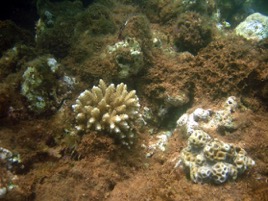Herbivory and predation
Understanding grazing and growth rates of algae in the Pilbara
Project leads: Mat Vanderklift (CSIRO); Gary Kendrick (UWA) and Ylva Olsen (UWA)
Herbivores play an important role in tropical reef systems. Reductions in herbivore abundances by overfishing or disease have altered the competitive balance on many reefs globally leading to a phase shift from a healthy coral reef to a degraded reef overgrown by macroalgae. The percentage cover of macroalgae on a reef is often used as an indicator of reef health as they can have a negative impact on coral health and reduce growth, survivorship, and recruitment.

Macroalgae and coral compete for space and macroalgae can be a major factor in reef degradation.
To understand what controls macroalgal cover in the Pilbara, the PMCP research team has quantified grazing and growth rates of algae.
The research team has measured growth and grazing rates in contrasting sites, offshore and inshore in the Dampier archipelago and at Ningaloo. Algae growing at these sites are subject to different environmental conditions and to different fish and invertebrate communities. These communities have been assessed as part of standard data collection in the PMCP coral reef health research project.
The PMCP researchers have also quantifed levels of chemical defense compounds (phenolics) in algal tissues, which have been shown to control grazer preference for a range of organisms. The spatial distribution of phenolic compounds have been assessed and linked to grazing rates.
